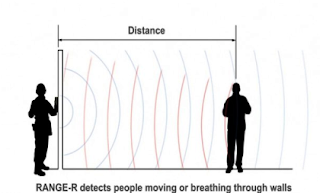As technology evolves into something that we only used to see in science-fiction movies, criminal mitigation initiatives are also improving, including the ability to detect if somebody is behind a thick wall.
Police forces are taking advantage of the new technology behind military equipment initially designed for combat.
USA Today reports that, for a couple of years now, some police forces have been using a device that can determine whether a building is occupied – without having to enter the premises. However, this information only came to light when a police officer at a suppression hearing in a Denver court said that he'd used a Range-R.
He described the Range-R as a "hand-held Doppler radar device." He added: "It picks up breathing, human breathing and movement within a house." In the Denver case, police were trying to apprehend someone who allegedly had violated his parole.
The Range-R's manufacturers explain that the device is to be held against a wall. Users then push a couple of buttons that send radar pulses through the wall to detect if anyone is inside. The device covers a conical view of 160 degrees. It works in a range of around 50 feet.
Though it "will penetrate most common building wall, ceiling or floor types – including poured concrete, concrete block, brick, wood, stucco glass, adobe, dirt" – the Radar-R does not work through metal. Moreover, if a wall is saturated with water, this also may reduce the device's effect. The device costs around US$ 6,000.
Clearly, though, those who still value their privacy will be concerned. What's to stop any member of law enforcement from placing one against anyone's wall just to see if they're home? Theoretically nothing.
That said, in 2013, the Supreme Court heard the case of Florida vs Jardines. Here, police led a drug-sniffer dog to a suspect's porch. The dog detected marijuana plants. The suspect was arrested. The court suppressed that evidence. Citing the Fourth Amendment, the court argued for "the right of a man to retreat into his own home and there be free from unreasonable governmental intrusion." It added that the area immediately surrounding the home "is part of the home itself for Fourth Amendment purposes."
With the Range-R, you may not even know the intrusion is happening.
Police forces are taking advantage of the new technology behind military equipment initially designed for combat.
USA Today reports that, for a couple of years now, some police forces have been using a device that can determine whether a building is occupied – without having to enter the premises. However, this information only came to light when a police officer at a suppression hearing in a Denver court said that he'd used a Range-R.
He described the Range-R as a "hand-held Doppler radar device." He added: "It picks up breathing, human breathing and movement within a house." In the Denver case, police were trying to apprehend someone who allegedly had violated his parole.
The Range-R's manufacturers explain that the device is to be held against a wall. Users then push a couple of buttons that send radar pulses through the wall to detect if anyone is inside. The device covers a conical view of 160 degrees. It works in a range of around 50 feet.
Though it "will penetrate most common building wall, ceiling or floor types – including poured concrete, concrete block, brick, wood, stucco glass, adobe, dirt" – the Radar-R does not work through metal. Moreover, if a wall is saturated with water, this also may reduce the device's effect. The device costs around US$ 6,000.
Clearly, though, those who still value their privacy will be concerned. What's to stop any member of law enforcement from placing one against anyone's wall just to see if they're home? Theoretically nothing.
That said, in 2013, the Supreme Court heard the case of Florida vs Jardines. Here, police led a drug-sniffer dog to a suspect's porch. The dog detected marijuana plants. The suspect was arrested. The court suppressed that evidence. Citing the Fourth Amendment, the court argued for "the right of a man to retreat into his own home and there be free from unreasonable governmental intrusion." It added that the area immediately surrounding the home "is part of the home itself for Fourth Amendment purposes."
With the Range-R, you may not even know the intrusion is happening.


No comments:
Post a Comment